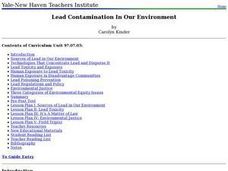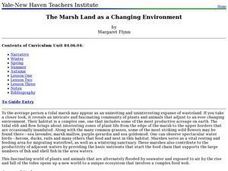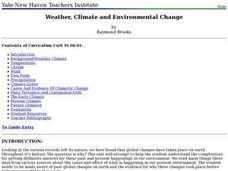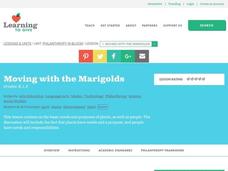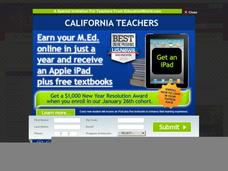Curated OER
Project Helping Hands
Students work as a team to help improve the quality of life in rural Africa and develop a plan how to spend grant money the United Nations has provided them with.
Curated OER
Insects Are Helpful!
Students see that insects do lots good and are very valuable to humans and nature. This is part of an ongoing effort to dispel fears of insects. They rotate through a series of centers that have examples of how insects contribute to our...
Curated OER
Lead Contamination In Our Environment
Learners identify the sources of lead in their local community and how to prevent further contamination. As a class, they watch a video about the effects of lead on the body and use the internet to discover any new technology that can...
Curated OER
The Marsh Land as a Changing Environment
Sixth graders continue their examination of the state of Connecticut. After taking a field trip, they identify the types of birds, plants, invertebrates and vertebrates who make their home in the salt marshes. In groups, they identify...
Curated OER
Repair, Reuse, Recycle
Students read "Joseph had a Little Overcoat" and explain why his clothing didn't go to waste. In this repairing, reusing, recycling lesson, students recognize by reusing objects they help the environment. Students write their ideas for...
Green Education Foundation
How Loud is Too Loud?
Ever wonder how loud a sound has to be to cause damage? Young scientists explore sound properties by researching decibel levels. They discuss how sound is perceived by our ears and our brains and why it can cause negative health effects...
Curated OER
Earth: Our Big Blue Marble
Students investigate Earth and its resources. For this Earth, space, and nature lesson plan, students collaborate to design presentations on the Earth, its cycles, and how humans have impacted the planet. Images, diagrams, and background...
Perkins School for the Blind
Where Shall I Put It?
Position and positional phrases are concepts that need to be constructed for learners with low or no vision. Help them gain competence and a conceptual understanding of words like on, in, and under with a funny game. After gathering a...
US Environmental Protection Agency
Getting to the Core: The Link Between Temperature and Carbon Dioxide
Polar ice samples provide scientists with valuable information about the condition of the atmosphere for hundreds of thousands of years in the past. Of particular interest is the amount of carbon dioxide in the atmosphere and its...
Polar Bears International
Taking Action!
Motivate young scientists to stand up and take action with this environmental science lesson. To begin, the class works in small groups brainstorming actions that support the conservation of the earth before creating and implementing an...
California Academy of Science
Coincidental Colonization
The Galápagos Islands are an amazing place of isolated adaptation, colonized by an interesting mix of plants and animals. The class plays a game to help them understand how these organisms came to live on the island through a combination...
Rainforest Alliance
Who Takes Care of the Maya Forest Corridor?
Who keeps animals safe? Who keeps us safe? Discover the helpers that make learning and growing possible through a medley of activities that focus on habitats—ours and those in the rainforest. Scholars are asked to identify one...
ESL Kid Stuff
Classroom Objects
How many classroom objects can your learners identify? Use a set of activities based on object recognition and color matching to help young kids use their observation to learn new vocabulary.
Perkins School for the Blind
The Mystery Box - Making Observations and Collecting Data
Making observations and collecting qualitative and quantitative data is a vital skill all scientists need to practice. Help your scientists with partial and no sight learn how to use their other senses to make observations for...
Baylor College
Water in Your Body
Do you know how much water you have had in the last 24 hours? Do you know how much your body needs? In this hands-on activity, your class members will estimate how much water our bodies lose each day by filling and emptying one-liter...
Curated OER
Encountering Very Different Ways of Life
Students explore the concept of crossing cultures through reading the stories "Help! My Father is Coming!" and "The Visit to Vijay's." In this culture lesson, students predict what will happen next in the stories. Students discuss the...
Curated OER
Weather, Climate and Environmental Change
Students study the complexities for getting definitive answers for past and present happenings in our environment. They discover past global changes on earth and the evidence for why these changes took place before believing everything...
Curated OER
Moving with the Marigolds
Students discuss the purpose and needs of flowers and how they help our environment. For this flowers lesson plan, students discuss flowers and how they grow and what people need to do to help them.
Curated OER
Our Environment
Pupils engage in a literature study that helps students to connect with some of the issues of conservation. They list parts of the environment that need protection with the help of a graphic organizer. Then pupils discuss in groups why...
Curated OER
Relating Maya
Students read about the bags that the Maya people made and about how reusing bags can help save our environment. In this environment lesson plan, students read and discuss conservation and observe pictures.
Curated OER
Climate And the Greenhouse Effect
Students demonstrate the greenhouse effect. They recognize that relatively small changes to our environment can stimulate significant climate changes. They determine that the "scientific method" is a process of testing hypotheses and...
Curated OER
Planting Trees to Help the Planet
Young scholars react to a series of statements about trees, then read a news article about the planned planning of millions of trees to celebrate Arbor Day. In this planting trees lesson plan, the teacher introduces the article with a...
Curated OER
Water: Our Most Important Beverage
Third graders create a KWL chart about water. For this environmental science lesson, 3rd graders demonstrate how much water on Earth is usable. They act out the different stages of the water cycle.
Curated OER
Our Treasured Trees
Young scholars discuss natural resources and renewable resources with trees being considered renewable resources which need special attention. In this Earth science lesson, students write a list of reasons for why it would be good to...


